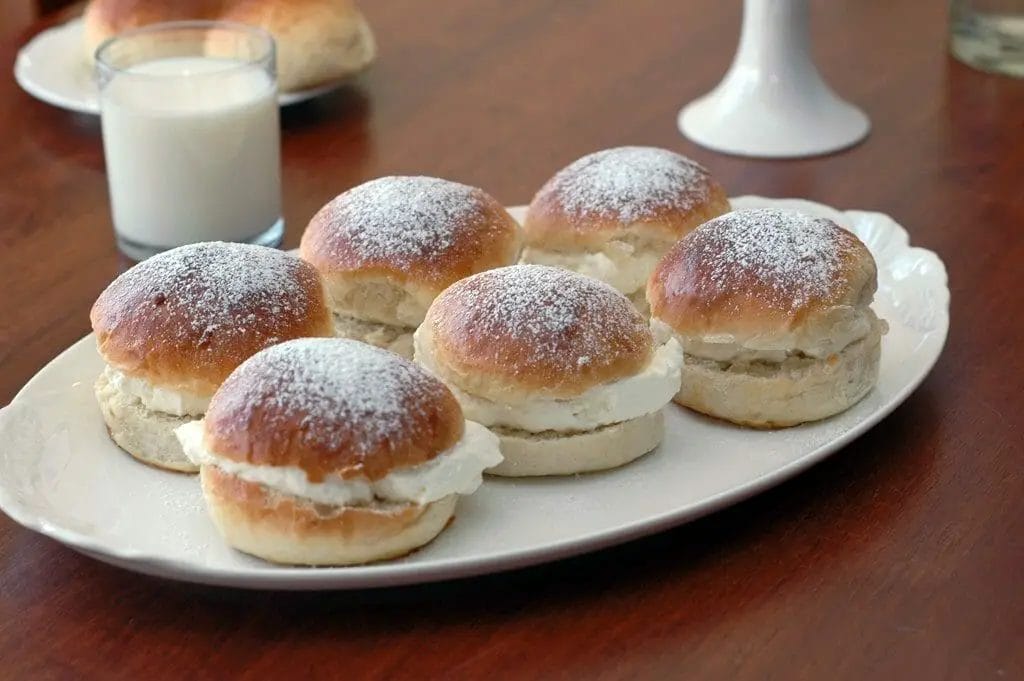
New Year in Denmark is often spent with friends rather than family. Young people go to party somewhere, as everywhere in the Western world, whereas older people often have neighbours, friends or relatives over for dinner.
A traditional New Year's dinner is steamed codfish with potatoes and side dishes like chopped, boiled eggs, preserved beets, capers and gravy. The dessert is traditionally marcipan cake.

Many watch the Danish Queen's address to the people on TV at 6pm. In Copehagen, a few minutes before midnight the bells of the town hall start ringing. When the clock strikes 12, it is time to have champagne, sing the national anthem and other songs in order to welcome the new year, say farewell to the old one and wish everybody a happy New Year. Afterwards, everybody goes outside to watch fireworks.
On the second of January life is almost back to normal and work starts again, though most children still have a few days left of their Christmas holidays. Most young people need the day to recover from the partying as well.
New Year in Denmark : The Queen's Speech

With the New Year fast approaching, it is anybody's guess what the Queen's New Year speech will be about. Queen Margrethe II's speech is much awaited every December 31st at 6 pm. It occupies one of the highest importance in Danish commmemoration of New Year, the other being the striking at midnight of the Town Hall clock in Copenhagen.
This practice has been observed since 1942 and has since served a rallying point for what the country hopes to achieve in the future as it recognizes its accomplishments. Queen Margrethe II has been at it from the time she ascended the throne in 1972. Her most memorable speeches are those that address the citizens on a more personal note.
The Queen's speech or the event itself has sparked interesting online betting activities in the recent years focused on guessing what the main key words will be used. This seemingly cavalier approach to the speech by Danes who participate in such activity is not borne of any disrespect to the monarch nor to the age-old tradition. It merely takes advantage of the accepted popularity of the event.
Listening to the Queen's New Year speech every year is very much a part of life of Danes. They accept and anticipate it in the same manner that they do with their common New Year's Day practices. New Year's Eve in Denmark is usually an event celebrated with friends unlike Christmas which is specifically set aside for family.
This is the time of the year where many Danes are found in hotels or local clubs either taking part in hotel-offered New Year's buffet or just plain partying with friends. As the Queen traditionally ends the year with her favorite last line “God Save Denmark” , so will Danes end their year with traditional fun.
New Year's Eve in Copenhagen

The Danish may not appear to celebrate the New Year’s Eve as much as they do Christmas – most locals actually prefer greeting the first day of the new year at home with their family and close friends. But in the capital city of Denmark, there would be plenty of fun parties and events especially for the younger set.
If you’re going to be in Copenhagen before the stroke of midnight on December 31st, check out these entertaining options for a happy New Year’s Eve: Hotel Parties and Lavish Spreads. Most of the hotels in Copenhagen offer New Year’s Eve buffets or dinner galas. Most of them would of course package the dinner, live music performance or dancing with an overnight stay in the hotel. But even if you are not staying in the hotel you can still get a ticket or a reservation for the activity. Check for the hotels’ respective promotional materials. Nightclub and Dance lounges. The nightclubs in Copenhagen will be pulling out all stops before the clock strikes twelve so if you are in the mood for pulsating, lively music and dancing the night (and the old year!) away then check out the top clubs and party places. Fireworks and Street Party.
Of course the city revelry won’t be complete without the traditional fireworks display at major places like the Radhuspladsen and the Town Hall Square. Revellers come with their own fireworks, party hats and champagne and transform the streets into one giant party venue, counting down the hours and minutes until the New Year.
New Year in Denmark : Fastelavn Is Here !
Happy Fastelavn!

Fastelavn is the Carnevale of Denmark, Norway, and the Faroe Islands. It is celebrated on a Sunday or Monday before Ash Wednesday, and is a day dedicated to light-hearted fun, sweet treats, and merriment. It's a day where both children and adults are encouraged to come dressed in their silliest costumes, sing sings for candy, and just generally have a good time.
On the morning of Fastelavn, parents flogged awake by their children with twigs. This is done all in fun, and the twigs are decoarated with crepe paper, feathers, candy and baby figurines all done in festive colors. As a reward for the whipping, the parents must get up and give their children sweet Fastelavenboller, or traditional cream- or -jelly-filled buns, to eat.
Another fun tradition that both the young and old can partake in is slå katten af tønden, or “hit the cat out of the barrel”. A bit unsettling as the name of the game may sound, it actually doesn't involve a real cat, but it certainly involves a barrel full of candy strung up from a branch, a whacking stick, and a picture of a black cat glued to its side. A line of people take turns attempting to whack the barrel while in a blindfold. The person who knocks the bottom of the barrel and makes all the candy spill out is dubbed katterdronning, or “The Queen of Cats”. The person to knock out the last piece of the barrel is dubbed kattekonge, or “the King of Cats”.
New Year in Denmark, the Fastelavnsboller recipe
New Year in Denmark mean Fastelavnsboller ! Fastelavnsboller are delightfully sweet buns that are served on Fastelavn, and are also called “shrovetide buns” or “lenten buns”. They are often filled with cream or jam, and are a favorite treat given to children who have flogged their parents in the morning, as tradition and good-natured fun recommends. This recipe will require some elbow grease and patience, but it will reward you with a batch of Fastelavnsboller that is good for sharing – just don't forget to enjoy one yourself!
Ingredients:
Dough:
- 1 cup milk
- 2 tbsp butter
- 4 tbsp fresh/cake yeast
- 1 tbsp sugar
- 1 tsp salt
- 3 and ¾ cups flour
- 1 egg
- 1 additional egg for glazing (optional)
Custard:
- 1 vanilla bean
- 1 cup milk
- 2 egg yolks
- 2 tbsp confectioner's sugar
- 1 tbsp cornstarch
If you prefer filling your Fastevalnsboller with jam, just replace the custard with a jam of your favorite flavor.
To make the dough :
Heat the milk and th ebutter until both are warm(not hot or scalding) to the touch, and the the butter is thoroughly melted. In a small bowl, break up the cake yeast and pour the milk over it; stir to dissolve the yeast. Add the sugar, salt and egg, and keep mixing. Take your flour, and add a little of it at a time as you mix. When the mixture has urned into a dough, knead it thoroughly until it becomes smooth. Place ina large bowl, cover it with a tea towel, and let it rise in a warm place for one hour.
To make the custard:
Cut the vanilla bean in half lengthwise, and scrape out the seeds with a sharp kitchen tool. Place the seeds and milk in a small saucepan and let it boil. (Tip: save the eggwhites for a step later.) Beat the egg yolks and sugar together until it becomes a cloud of sunshine yellow sweetness, then add the conrstarch. Take half of the vanilla-milk and as you keep beating the eggs, pour half of the milk in slowly. When the milk has been fully incorporated into the egg mixture, pour everything into the saucepan. Keep whisking the mixture over a low, gentle flame until the custard thickens. Be careful to not let the it boil! Remove from heat, pour into a bowl, and place some cling-wrap right on top of the custard surface to keep it from developing a skin. Cool in a refirgerator.
Assembling the buns :
Prepare two baking parchment sheets and set aside.
Take your dough which has fully risen by now, and prepare the kneading surface by sprinkling it lightly with flour. Knead the dough until it is silky-smooth and elastic. Take your rolling pin, dust it a bit with flour, and roll out the dough until it is roughly a square of 15×15 inches. Slice this up into a dozen squares.
You can opt to make buns of each square from here, line them up on the parchment paper pieces, and bake them as is. After they have cooled, you can slice them in half and add your custard or jam, and serve. However, if you want to make them the traditional custard-or-jam-pocket style, follow these instructions:
Take a square of dough, and place a heaping teaspoonfull of custard or jam in the center. With the leftover eggwhites, brush the edges of the square to help seal it. Take the four courners of the square, and pinch it closed, making sure to let the air out. When it has been fully sealed, turn the bun over and place on the baking parchment. Repeat this step to the rest of the dough squares. When they are all done, again place a tea towel over the buns and let them rise a bit forther in a warm place for another hour.
Baking :
Preheat the oven to 190 degrees Celsius, or 375 degrees Farhenheit. You may desire to break open your optional egg from the dough ingredients, beat in a small bowl, and brush the bun tops lightly to glaze them. Bake for ten to twenty minutes or until golden brown. Remove from the oven, and let cool before serving.
You may wish to cover the tops with choclate icing, and decorate them with candy sprinkes and colored dragees.
Happy baking and eating and happy New Year in Denmark !

Be the first to comment